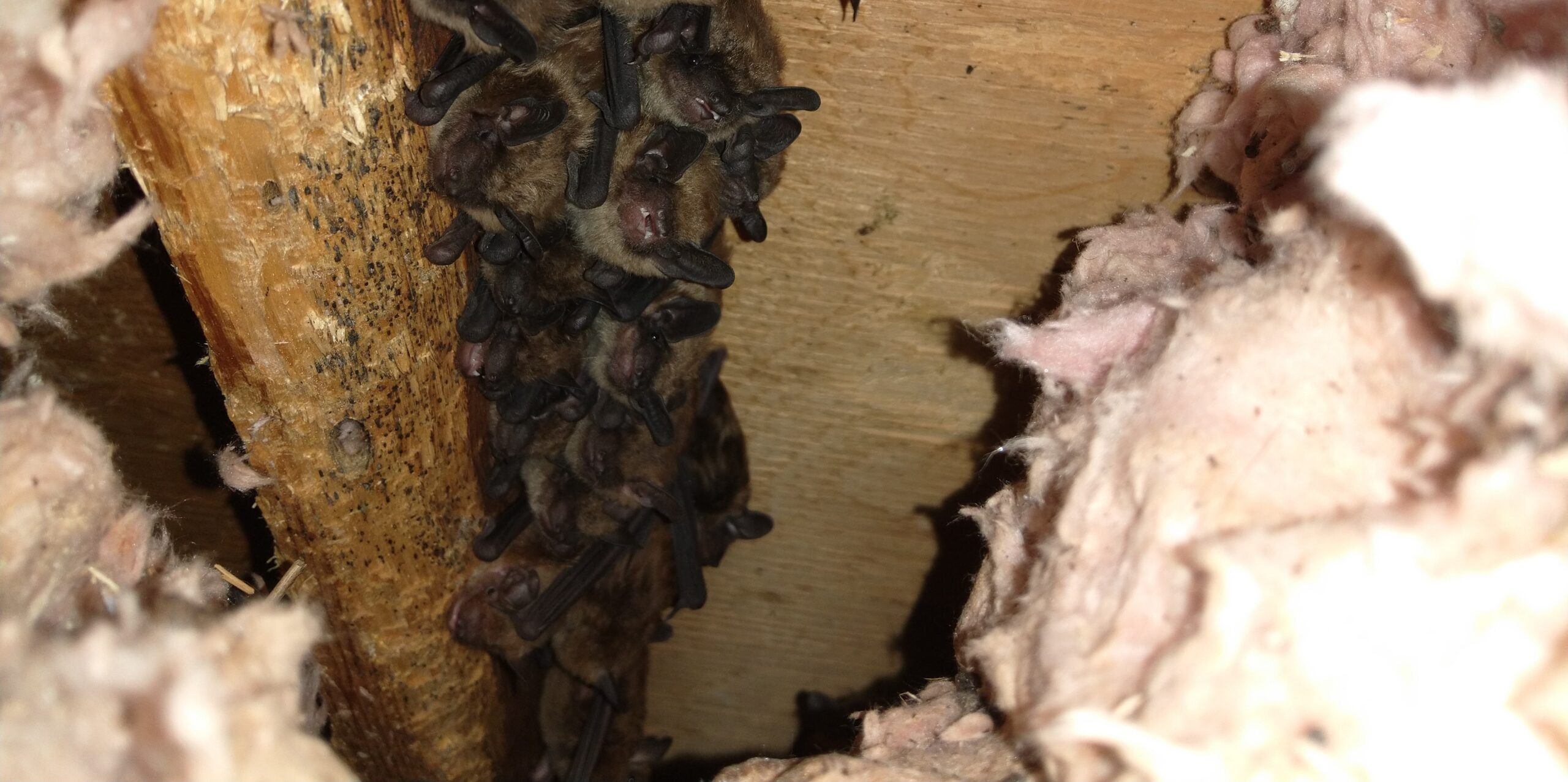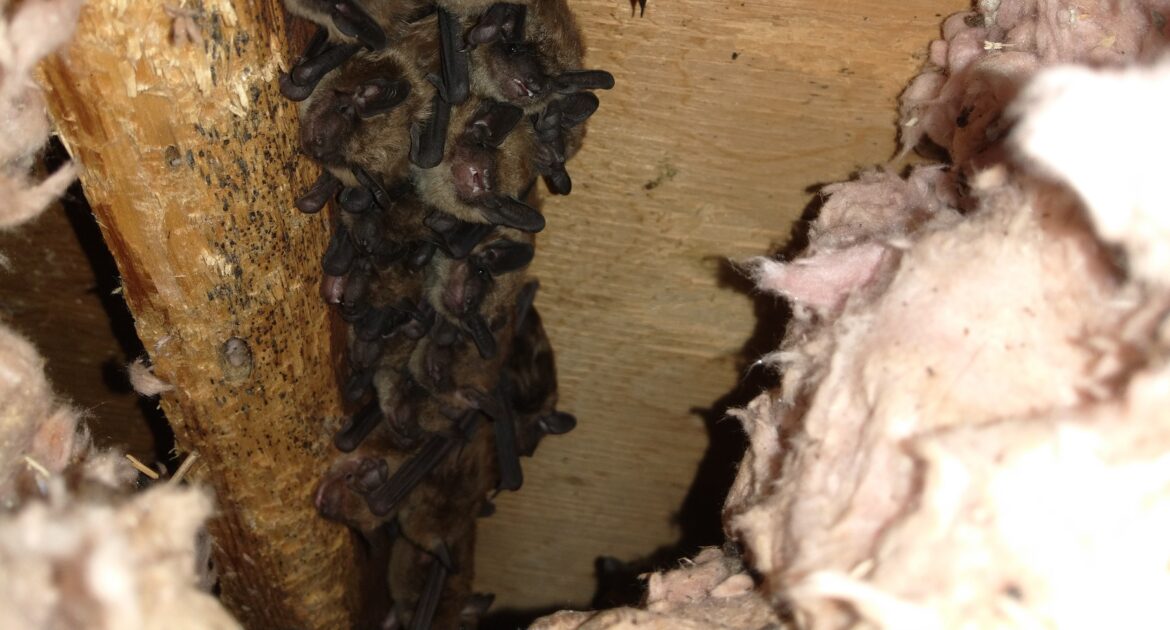Bats in basements are a common concern for homeowners across Waterloo. While most associate these winged mammals with attics and roof spaces, the truth is that their presence in basement areas is equally problematic and often harder to detect. Understanding the signs of bats in basement environments is crucial for early intervention and prevention of larger infestations.
Your cozy Waterloo basement might unwittingly be inviting bats to take up residence. These small, agile creatures can squeeze through openings as tiny as a dime, making basements particularly vulnerable to intrusions, especially during certain seasons when they’re seeking shelter.
At Skedaddle, we’ve spent over 30 years helping homeowners identify, remove, and prevent infestations in all parts of homes—including basements. Let’s explore how bats find their way into basements, the telltale signs of their presence, and what you can do to keep them out.
Recognizing Signs of Bats in Your Basement
Identifying a bat problem early can save you from extensive damage and potential health risks. While obvious signs like seeing a live bat are unmistakable, several subtler indications may go unnoticed without knowing what to look for.
Direct Evidence of Bat Presence
The most obvious signs of bats include:
- Droppings (guano): Small, dark pellets that resemble mouse droppings but crumble more easily and often accumulate in piles.
- Visual sightings: Actual bats flying or roosting in corners, rafters, or hidden spaces.
- Squeaking or chirping: Particularly noticeable at dusk or dawn when they are most active.
- Scratching sounds: Often heard within walls or ceilings as bats move around.
Droppings aren’t just unpleasant—they can harbour dangerous fungi that cause histoplasmosis, a serious respiratory infection if left untreated. Never handle guano without proper protection.
Indirect Signs That Are Often Missed
Beyond these obvious indicators, several subtle signs of bats in basement environments frequently go unnoticed:
- Unexplained staining: Oil from bat fur can leave yellowish-brown stains on walls or ceilings around entry points.
- Musty, ammonia-like odour: Accumulation of guano and urine creates a distinctive smell that intensifies over time.
- Temperature fluctuations: Areas with bat colonies may feel warmer than surrounding spaces due to their body heat.
- Increased insect activity: Fewer flying insects outdoors but more inside can indicate they are feeding nearby.
A single bat appearing inside your living space typically signals a larger issue. As our technicians have discovered through years of experience, when homeowners spot one bat, there’s almost certainly a colony somewhere in the structure. In basements, bats often enter through wall cavities that connect to upper levels where the colony resides.
How Bats Enter Basements
Understanding how bats access basements is essential for effective prevention. Unlike rodents, they cannot chew or create their openings—they exploit existing gaps and vulnerabilities in your home’s structure.
Common Basement Entry Points
Bats typically access basements through:
- Foundation cracks: Even hairline fractures can provide access for these flexible mammals.
- Utility penetrations: Openings around pipes, electrical conduits, and HVAC ducts.
- Poorly sealed windows: Gaps around basement windows, particularly older ones.
- Bulkhead or hatchway doors: Spaces around the edges that aren’t properly weatherproofed.
- Internal access: Wall cavities that connect to attics or upper floors where colonies reside.
Basement walls often have openings for plumbing, electrical, and HVAC systems. These create perfect pathways for bats that have already entered your home’s attic or walls to move down into basement spaces, especially when seeking cooler temperatures during hot summer months.
Seasonal Patterns of Basement Intrusion
Bat activity in basements tends to follow predictable seasonal patterns. During the summer months, activity increases as females establish maternal colonies and young bats begin exploring. In the fall, sightings in basements often rise as bats search for suitable hibernation spots. Winter brings reduced movement while they remain in hibernation, typically from September to April. As temperatures warm in spring, bats become active again, marking the start of a new cycle.
Our technicians at Skedaddle have observed that basement sightings often increase during extreme temperature periods, as bats move within a home’s structure seeking more comfortable conditions—cooler spaces during summer heat waves and warmer areas during cold snaps.
Preventing Bats in Your Basement: Effective Strategies
Preventing bats from entering your basement requires a comprehensive approach combining structural improvements, routine maintenance, and professional assessment.
Prevention Measures
While professional exclusion provides the most reliable protection, several homeowner actions can reduce your basement’s appeal to bats:
- Seal visible gaps: Use appropriate materials to close openings around pipes, vents, and foundation cracks.
- Install proper screens: Ensure all basement windows have intact screens with no tears.
- Improve lighting: Bats prefer dark, quiet spaces, so increasing natural or artificial light can deter them.
- Reduce humidity: Address moisture issues that might attract insects they feed on.
- Regular inspections: Check basement walls and ceilings monthly for new cracks or signs of entry.
Exclusion must be carefully timed. From June to August, females are raising pups that can’t fly. Sealing entry points during this period can trap helpless young inside, creating additional problems.
Professional Exclusion Methods
At Skedaddle, our exclusion process involves:
- Thorough inspection: Our trained technicians conduct a comprehensive 35-50 point property inspection to identify all potential entry points—even those as small as a dime.
- Colony assessment: We determine the colony size and breeding cycle phase to ensure humane removal.
- Strategic exclusion: Installation of one-way doors that allow exit but prevent re-entry.
- Comprehensive sealing: Application of our specialized wildlife exclusion sealant on all potential entry points.
- Contamination remediation: Safe removal and cleaning of affected areas, including treatment with odour control and bacteria digesters.
Our service is set apart by our understanding of bat biology. We know that removing bats requires precise timing—working around hibernation periods (September to April) and the June-August baby season when removals could orphan dependent pups.
Long-Term Protection Strategies
Maintaining a bat-free basement requires ongoing vigilance:
- Annual inspections: Professional assessment to catch developing issues.
- Maintenance of seals: Checking that exclusion measures remain intact.
- Exterior management: Keeping your property less attractive to bats by managing outdoor lighting and insect populations.
- Structural repairs: Addressing foundation issues promptly to prevent new entry points from forming.
The Risk of DIY Bat Removal
Many homeowners attempt to handle bat issues themselves, leading to serious consequences. Here’s why professional intervention is critical:
Health and Safety Concerns
Attempting DIY removal presents several risks:
- Disease exposure: They can carry rabies, and droppings harbour fungi that cause histoplasmosis.
- Legal issues: Bats are protected in many regions, with strict regulations about their removal.
- Incomplete solutions: Addressing visible individuals without locating the colony ensures the problem will continue.
- Property damage: Improper removal techniques may drive bats deeper into your home’s structure.
When to Call Professionals
Contact wildlife removal experts like Skedaddle immediately if you find a single bat in your living space, notice guano or signs of entry, or experience a sudden increase in insect activity inside your home, which could indicate the presence of bats feeding nearby.
By entrusting bat issues to professionals, you ensure both effective resolution and compliance with regional wildlife protection laws. Our team at Skedaddle offers the expertise and humane strategies needed to maintain a safe and healthy living environment.
If you suspect bats have taken up residence in your basement, don’t wait for the problem to escalate. Contact Skedaddle today for a professional assessment and tailored exclusion strategy. Let us help you protect your home and restore your peace of mind with swift, effective solutions.




